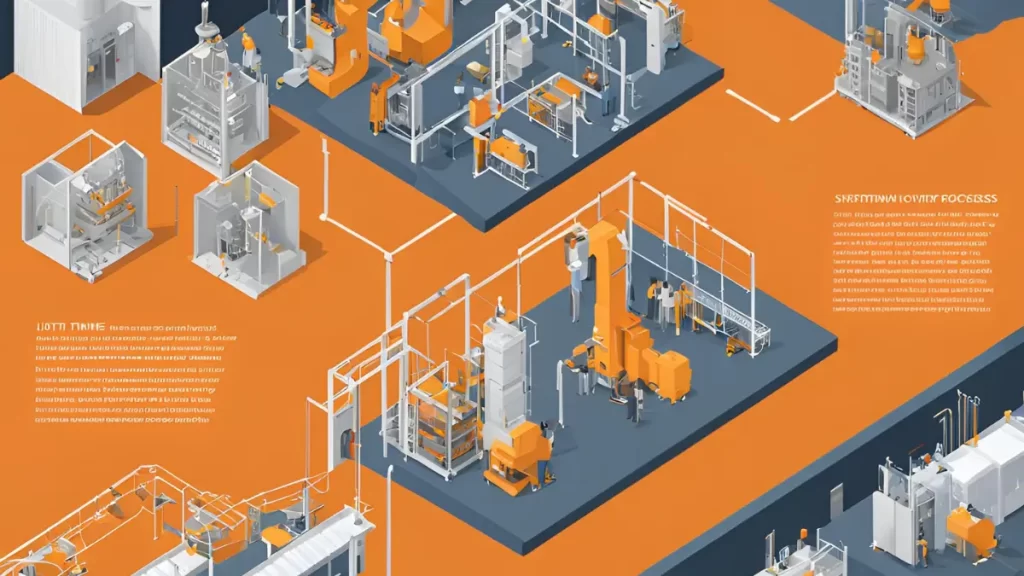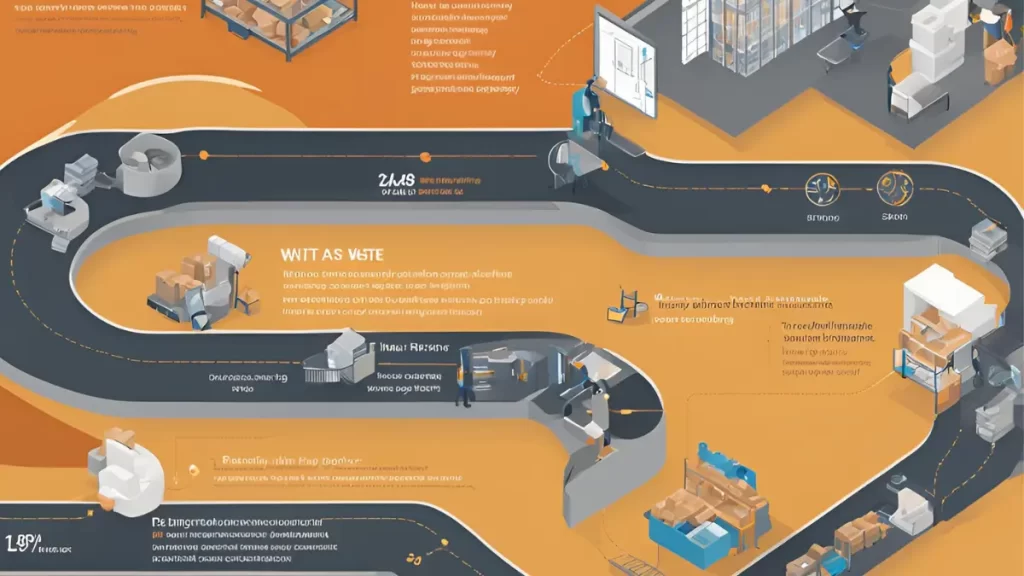Are you a manufacturing business in Singapore looking to enhance your inventory management and streamline your supply chain? Just-in-Time (JIT) manufacturing might be the solution you need. JIT manufacturing, also known as the JIT system, is a lean production strategy that focuses on optimizing inventory management, reducing costs, and improving overall efficiency. By implementing this production strategy, you can align your production with customer demand, minimize excess inventory, and enhance your supply chain optimization.
JIT manufacturing operates on the principle of producing goods or delivering materials exactly when they are needed, eliminating waste and reducing inventory carrying costs. This pull-based system ensures that materials and components are delivered to the production line or assembly area just in time for use, eliminating the need for large stocks of inventory. With JIT manufacturing in place, you can optimize your production planning, minimize costs, and meet customer expectations with efficient manufacturing processes.
In the following sections, we will explore what JIT manufacturing entails, its advantages, and how successful companies like Toyota, Apple, and McDonald’s have leveraged JIT to improve their inventory management and production efficiency. We will also delve into other inventory optimization techniques such as Collaborative Planning, Forecasting, and Replenishment (CPFR), Material Requirements Planning (MRP), and batch size optimization. By the end of this article, you will have a comprehensive understanding of JIT manufacturing and how it can benefit your business in Singapore.
Key Takeaways
|
Table of Content:
Table of Content

What is Just-in-Time (JIT) Manufacturing?
Just-in-time (JIT) manufacturing is an inventory management strategy that aims to produce goods or deliver materials precisely when they are needed. This approach eliminates excess inventory and reduces waste, making the production process more efficient.
In a JIT system, raw materials and components arrive at the production line or assembly area just in time for use, eliminating the need for large stocks of inventory. By implementing JIT, companies can optimize their inventory management and minimize the costs associated with carrying excess stock.
The key to successful JIT manufacturing is accurate demand forecasting, which allows businesses to align production with customer demand. Effective production scheduling ensures that the production process flows smoothly and avoids any delays or interruptions.
JIT manufacturing also relies on close collaboration with suppliers to ensure timely deliveries. By working closely with suppliers, companies can ensure that materials and components arrive just in time for use, reducing the need for extensive inventory storage.
Implementing a JIT system offers several benefits, including waste reduction, improved production flow, and enhanced overall efficiency. With JIT manufacturing, companies can streamline their operations, reduce costs, and meet customer expectations more effectively.
Collaborative Planning, Forecasting, and Replenishment (CPFR)
Collaborative Planning, Forecasting, and Replenishment (CPFR) is an optimization technique that emphasizes collaboration and information sharing between trading partners to improve demand forecasting accuracy and enhance supply chain efficiency. By implementing CPFR, businesses can streamline their inventory management processes and achieve better operational performance.
With CPFR, manufacturers, distributors, and retailers can collaborate on forecasting customer demand, align planning activities, and coordinate replenishment efforts. This collaborative approach minimizes forecast inaccuracies and reduces inventory holding costs, allowing businesses to optimize their inventory levels and meet customer expectations.
CPFR enables supply chain collaboration by facilitating the sharing of information and jointly planning with trading partners. This ensures that all stakeholders are on the same page, resulting in improved demand forecasting accuracy and better inventory management.
Implementing CPFR can bring several benefits to businesses. By enhancing demand forecasting accuracy, companies can optimize their inventory levels, reduce carrying costs, and improve overall supply chain efficiency. This leads to improved operational performance and customer satisfaction.
Implementing CPFR as part of your inventory management strategy can help you optimize your supply chain collaboration, improve demand forecasting accuracy, and enhance overall inventory management. By collaborating with your trading partners and sharing information, you can streamline your inventory processes, reduce costs, and meet customer demands more effectively.
Material Requirements Planning (MRP)
Material Requirements Planning (MRP) is a crucial technique in the field of production planning and inventory management. By utilizing demand forecasts and bills of materials, MRP enables manufacturers to plan and schedule procurement or production activities effectively.
With MRP, businesses can ensure the availability of suitable materials at the right time, eliminating issues such as stockouts and excess inventory. By considering lead times and optimizing production scheduling, MRP minimizes production delays and idle time. This approach allows companies to align their production with the actual demand, optimize inventory levels, and enhance overall supply chain efficiency.
Implementing MRP brings several benefits to manufacturers. By effectively managing material requirements, businesses can reduce costs, improve production planning, and achieve better inventory optimization. With the ability to accurately forecast demand and plan production accordingly, MRP helps minimize stockouts and excess inventory, ultimately improving operational efficiency.
By adopting MRP, businesses in Singapore can streamline their inventory management processes and overcome the challenges associated with supply chain management. With its ability to align production with demand, optimize inventory levels, and reduce costs, MRP plays a vital role in enhancing overall operational performance and achieving customer satisfaction.
Just-in-Time (JIT) and Kanban Systems
The Just-in-Time (JIT) and Kanban systems are two complementary approaches that can greatly optimize manufacturing inventory and improve overall efficiency. JIT, also known as a JIT system, focuses on producing and delivering goods just-in-time, precisely when they are needed. This approach eliminates excess inventory and reduces carrying costs, making it an efficient and cost-effective inventory management strategy.
With JIT, production is aligned with customer demand, resulting in faster turnaround times, reduced lead times, and improved responsiveness. By minimizing inventory holding costs and eliminating waste, JIT enables businesses to optimize production planning and maximize operational efficiency. Implementing a JIT system can significantly streamline inventory management and enhance supply chain performance, ultimately benefiting both the business and its customers.
Another crucial component of inventory optimization is the Kanban system, a pull-based system designed to ensure smooth material flow and control throughout the production process. The Kanban system utilizes visual cues, such as cards or electronic signals, to indicate when materials or components need replenishment at each production stage.
By implementing the Kanban system, manufacturers can minimize waste and optimize inventory levels. The pull-based nature of the Kanban system ensures that production only occurs when necessary, reducing the risk of overproduction and unnecessary inventory buildup. This leads to improved efficiency, waste reduction, and streamlined production flow.
Combining the principles of JIT and the Kanban system allows businesses to achieve even greater inventory optimization and waste reduction. By integrating these two approaches, manufacturers can eliminate waste, reduce inventory levels, improve production flow, and achieve enhanced efficiency and customer satisfaction.
Batch Size Optimization
When it comes to optimizing manufacturing inventory, batch size optimization plays a crucial role. By determining the optimal production batch size, you can minimize setup costs and reduce inventory carrying costs. Smaller, more frequent batches not only help reduce setup time and resources, resulting in significant cost savings but also ensure that your inventory levels align with demand. This means you can effectively manage storage costs and minimize the risks of obsolescence.
One of the key benefits of batch size optimization is the enhancement of production flexibility. By adopting an optimized batch size approach, you can quickly respond to market changes and customer preferences. This agility allows you to stay ahead of the competition and meet the ever-evolving demands of your customers.
Implementing batch size optimization not only improves operational efficiency but also minimizes inventory waste. By producing goods in smaller batches, you can avoid excess inventory and prevent obsolescence. This lean approach to inventory management ensures that you have the right amount of inventory at the right time, leading to better cost control and improved overall inventory management.
In summary, batch size optimization is an indispensable strategy for optimizing manufacturing inventory. By determining the right batch size, you can reduce setup costs, minimize inventory carrying costs, enhance production flexibility, and improve overall inventory management.
Inventory Segmentation and ABC Analysis
Optimizing your manufacturing inventory requires a structured approach to prioritize and allocate resources effectively. This is where inventory segmentation and the ABC analysis technique come into play. Through ABC analysis, you can categorize your inventory items into three categories: A, B, and C.
Category A items represent high-value or high-demand products that require closer attention and faster replenishment to prevent stockouts and meet customer demands. These items are critical to your business and should be managed with utmost priority. Category B items, on the other hand, have moderate value or demand and require intermediate management efforts. Finally, Category C items are lower-value or low-demand products that can be managed with less control, allowing you to minimize carrying costs.
By segmenting your inventory and allocating resources based on the specific characteristics and importance of each item, you can improve operational efficiency, reduce costs, and optimize your overall manufacturing inventory performance. This approach ensures that your inventory management efforts are aligned with the value and demand of each item, enabling you to make informed decisions and streamline your inventory management process.
Implementing inventory segmentation and ABC analysis is a strategic move towards effective resource allocation and inventory management. It empowers you to focus on the items that truly matter, preventing stockouts, minimizing carrying costs, and ultimately enhancing your operational efficiency.
Just-in-Time (JIT) Success Stories: Toyota, Apple, and McDonald’s
Just-in-time (JIT) manufacturing has been successfully implemented by various companies, including Toyota, Apple, and McDonald’s. These success stories highlight the effectiveness of JIT in reducing waste, improving production efficiency, and enhancing customer satisfaction.
Toyota:
Toyota, being an early adopter of JIT, has implemented this system by ensuring that raw materials are not brought to the production floor until an order is received from the customer. This approach minimizes inventory and allows Toyota to adapt quickly to customer demands. By implementing JIT, Toyota has achieved efficient inventory management, streamlined production processes, and reduced waste.
Apple:
Apple leverages JIT principles by outsourcing production to suppliers and maintaining a centralized warehouse. By closely collaborating with suppliers and adopting dropshipping, Apple reduces costs and eliminates the risk of overstock. This JIT approach enables Apple to ensure efficient inventory management and timely product delivery.
McDonald’s:
McDonald’s utilizes JIT inventory management to serve customers efficiently. By assembling products only after an order is placed, McDonald’s minimizes waste and optimizes production resources. This approach ensures that customers receive fresh and made-to-order items, leading to enhanced customer satisfaction and improved operational efficiency.
These JIT success stories demonstrate the significant impact of JIT manufacturing on inventory management, production efficiency, and waste reduction. Implementing JIT principles can help businesses in Singapore optimize their operations, improve supply chain efficiency, and meet customer expectations.
Advantages of JIT Inventory Management
JIT inventory management offers several advantages for businesses in Singapore. One of the key advantages is waste reduction. By implementing JIT, you can minimize waste in your inventory by eliminating excess stock and reducing storage costs.
Efficiency is another significant advantage of JIT inventory management. With JIT, you can streamline your production and delivery processes, ensuring that materials and components arrive just in time for use. This improves overall efficiency and productivity.
JIT inventory management also improves inventory turnover, allowing you to optimize your working capital. By reducing excess inventory and improving production flow, you can reduce obsolescence risks and keep your inventory levels lean.
Cost savings are a prominent benefit of JIT inventory management. By reducing waste, minimizing inventory carrying costs, and optimizing production, you can save costs associated with holding inventory, such as storage space and carrying costs.
Other advantages of JIT inventory management include improved quality control, faster product turnaround, and simplified change orders. With JIT, you can enhance your overall supply chain efficiency, reduce costs, and improve customer satisfaction.
JIT Inventory Methodology
The JIT inventory methodology, based on lean management principles, focuses on waste reduction and process optimization. By implementing this methodology, businesses strive to achieve greater efficiency and productivity in their operations.
In the JIT inventory methodology, several techniques are employed to minimize waste. One such technique is maintaining physical and organizational discipline, which involves creating a structured and organized work environment. This helps reduce the likelihood of errors and enhances overall operational efficiency.
Continuous improvement is another essential aspect of the JIT inventory methodology. By striving for ongoing improvement, businesses can identify and eliminate defects in their processes, further reducing waste and improving overall quality.
Reducing setup time is also crucial in the JIT inventory methodology. By streamlining setup processes, businesses can minimize downtime and improve overall productivity.
Small Lot Sizes
One key element of the JIT inventory methodology is the utilization of small lot sizes. By producing goods in small batches, businesses can minimize in-process inventory, reduce the risk of obsolescence, and optimize the utilization of resources.
The implementation of small lot sizes enables a more flexible production process, allowing businesses to quickly adapt to changes in customer demand and market trends. It also facilitates faster product turnaround times, reducing lead times and improving overall customer satisfaction.
Transparency and Visibility
Transparency and visibility are fundamental principles in the JIT inventory methodology. By ensuring transparency throughout the production process, businesses can identify and address bottlenecks, inefficiencies, and waste.
Visibility is achieved through the use of visual management tools, such as Kanban boards, which provide real-time information on the status of production and inventory levels. This enables better decision-making and facilitates effective inventory management.
By embracing the JIT inventory methodology, businesses can streamline operations, reduce waste, and improve overall efficiency. This approach promotes lean management practices, fosters continuous improvement, and enhances overall supply chain performance.
Overcoming Challenges in JIT Inventory Management
JIT inventory management presents several challenges that businesses need to address for successful implementation. One of the key challenges is accurate demand forecasting. Properly forecasting demand is crucial to ensure that the right amount of inventory is available at the right time. Without accurate demand forecasting, businesses may either face stockouts or end up with excess inventory, both of which can have negative financial implications.
Another challenge in JIT inventory management is coordinating with suppliers and maintaining a reliable supply chain. JIT relies heavily on timely deliveries of materials and components to ensure smooth production. Failure to coordinate effectively with suppliers can lead to disruptions in the supply chain, resulting in delays and inefficiencies.
Moreover, JIT inventory management requires close collaboration and information sharing between trading partners. Establishing and maintaining this level of collaboration can be challenging, especially when working with multiple suppliers. Effective communication, accurate data analysis, and a robust supplier relationship are essential in overcoming this challenge.
By addressing these challenges, businesses can enhance their JIT inventory management practices. Accurate demand forecasting enables businesses to meet customer demands without incurring unnecessary holding costs. Coordinating with suppliers and maintaining a reliable supply chain ensures that materials and components arrive on time, supporting smooth production. Close collaboration between trading partners promotes transparency, efficiency, and trust in the JIT system, resulting in optimized inventory management and improved supply chain performance.
Conclusion
In conclusion, Just-in-Time (JIT) manufacturing presents a powerful strategy for optimizing inventory management and enhancing supply chain efficiency. By adopting JIT principles, businesses can significantly reduce waste, lower inventory carrying costs, and improve production flow. Accurate demand forecasting, effective production scheduling, and close supplier collaboration are crucial for successful JIT implementation.
For businesses in Singapore looking to streamline their operations and enhance competitiveness, embracing JIT manufacturing can lead to improved inventory management, reduced lead times, and higher customer satisfaction. Investing in a robust JIT system is a strategic choice for maximizing operational performance and achieving supply chain excellence.
To experience the benefits of JIT firsthand, consider trying HashMicro‘s Manufacturing Software. Our comprehensive solution can help you implement JIT principles effectively, optimize your production processes, and achieve your business goals. Request a free demo today and discover how HashMicro can transform your manufacturing operations.























































